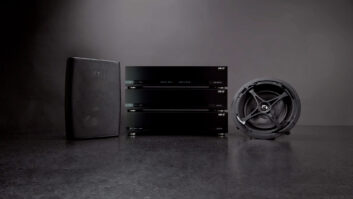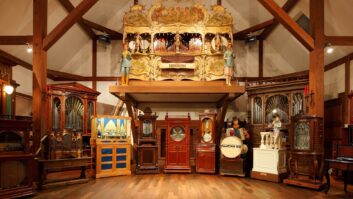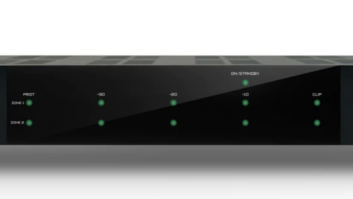There’s always that one room, isn’t there? No matter how big or small the house, no matter how extensive or focused the control system, there’s always that one room that ends up with too much or too little in the way of automation and/or entertainment.
Maybe it’s a bedroom with an old TV and media streamer that doesn’t justify the addition of another automation controller, but could still benefit from some integration with the rest of the house. Maybe it’s an out-of-the-way office that would be served well by a zone of audio, but for some reason you just can’t reach it with in-ceiling wiring and speakers. You’ve probably seen it dozens of times in all its various incarnations.

If so, you will understand why I’m completely in love with the new Triad One Single-Zone High-Resolution Streaming Amplifier. The Triad One, as you might imagine, is the child of Triad’s marriage with Control4, and just from seeing its full name alone, you’re probably already starting to dream up a few use cases. But hang on a second, because the name doesn’t tell the whole story.
Yes, indeed, the Triad One is a single-zone amp, perfect for easily tacking on an extra zone of audio to your larger distribution systems. It’s so much more than that, though. Add in Wi-Fi capabilities mentioned nowhere in its formal name, and you start to get a clearer picture of what you can do with it (at least, you can if you remember the Control4 wireless speaker point that sailed off into the sunset a few years back).
But wait, he says in his best Billy Mays voice, there’s more! It’s also a scaled-down automation controller of sorts, thanks to its two IR control ports. Combine that with its digital audio input (your choice of optical or coaxial), subwoofer out, and solid 60 watts per channel of amplification (8 ohms, 1-percent THD @ 1kHz), and the Triad One could almost be considered more of a network-connected 2.1-channel receiver with multi-zone audio capabilities than a mere streaming amp.
I began my time with the Triad One by installing it in the bedroom, in the place of my existing AV receiver and Control4 EA-1 entertainment and automation controller. I routed the signal from my Dish Joey and OPPO Blu-ray player directly to my TV via HDMI, connected the TV’s optical audio output to the digital input of the Triad One, and ran its IR outputs to the TV and OPPO. (The Joey is IP controlled, so I was good there.) For speakers, I connected a pair of RSL CG3 bookshelves and an RSL Speedwoofer 10.

The result was a fully functional 2.1-channel AV system, complete with third-party device control, for $700. And it took me all of 10 minutes to set up and program.
In practice, the little Trad One provided all the amplification I needed to enjoy movies and TV in the room, and it certainly eliminated a lot of clutter. Measuring in at just 3 x 8.5 x 10.25 inches, it certainly took up a lot less space on the credenza than the AV receiver and automation controller it replaced. And while it’s true that going this route doesn’t give you an onscreen Control4 UI in that room, with such a simple AV system, it doesn’t really matter.
Here’s the thing, though: as I said, I already have a receiver and automation controller in that room. What I’ve really needed for the past few months is a good two-channel integrated amp in my home office, tied into my larger Control4 system. Which brings us back to the “one damned room” problem I mentioned in the intro. Was it enough of a need to add a dedicated automation controller just to operate one integrated two-channel amp? The answer to that question was right on the cusp between yes and no.
With the Triad One, though, it’s not even a question. I dropped it between my pair of Paradigm Studio 100 towers, tinkered around in the Composer Pro software for about two minutes, and had a complete two-channel audio system that not only controls itself, but also acts as a fully connected piece of my overall whole-home audio system. The setup parameters found within the Composer Pro software for the Triad One are straightforward and intuitive, but they cover all the bases. You can set the Triad One to connect to the network wirelessly, but as with any Control4 controller, that requires first connecting it via Ethernet and performing a bit of reconfiguration within the System Manager.
If you’re running a subwoofer, you can select one of six crossover settings between 80 and 140 Hz, make tweaks to the Triad One’s 10-band equalizer if needed, engage mono summing (which could be handy if you’re using the unit to add a zone of outdoor audio), adjust delay for streaming sources if necessary (in 10ms increments), apply source leveling if you’re connecting devices directly to the amp, and/or choose whether the audio from any such sources is available only locally or via the network.
Aside from making my connections in Composer, though, all I had to do was drop a ShairBridge driver into the room with the Triad One to add an AirPlay zone, and plug in a USB stick full of high-res tunes.
In terms of two-channel performance, I have to admit I wasn’t expecting quite as much as what the Triad One delivers; 60 watts per channel may not sound like much, but it’s more than enough to rock a pair of full-sized towers quite raucously in my medium-sized office. Mind you, I won’t insult your intelligence by claiming that it matched the $6,000 integrated amp that I’ve been reviewing in terms of absolute transparency and dynamic punch. Then again, neither did it sound like a device that costs one-ninth as much. It’s a totally satisfying little over-achiever that oughta put a grin on the faces of all but the stodgiest of audiophiles.

And any slight loss in fidelity is more than made up for by the convenience of having my two-channel music in the office tied into every audio zone in the home, with the mere addition of one tidy little inexpensive black box. Bottom line? Yeah, I would kinda rather have this than the $6,000 integrated amp.
Mind you, there are still a few things I would change if I could. Well, one thing in particular. I know it seems positively old school of me, but I would punch a baby koala to get a volume knob on the front of this thing. And I know what you’re thinking: “But why?! You’ve got all the control you ever need and more in the palm of your hand!” True. But the Triad One lends itself to so many different applications, so many of them up-close and intimate, that I think a volume knob would serve it well. Add some tactile volume control, for example, and I would use this thing as the center of a desktop computer audio system in a heartbeat. I also wouldn’t mind some actual speaker binding posts instead of phoenix connectors, but maybe that’s just me.
At any rate, if those are the only nits I have to pick, I’d say Control4 and Triad have something pretty special on their hands here. Its deft mix of simplicity and versatility make it the perfect solution to all sorts of problems. The only real question is: which problems will it solve for you?
800.666.6316
Kudos
A fully functional 2.1-channel integrated amplifier, streaming audio player, and home automation controller in one box? What more could you ask for?
Concerns
A volume knob, maybe? But that’s about it.
Product Specs
* Inputs: 1 analog stereo and 1 digital (S/PDIF coax or Tosklink optical)
* Outputs: 1stereo analog out, 1 sub/mono audio out, stereo speaker outputs (phoenix-style connector)
* USB 2.0 port: supports playback of media
* Control: 2 3.5mm IR ports, one RJ45 Ethernet port (10/100/1000BaseT)
* Wi-Fi: 2 internal antennas, 2.4GHz and 5.0GHz
* Power: >60 watts per channel (8?, 1% THD @ 1kHz), >100 watts per channel (4 ohms, 1% THD @ 1kHz)
* THD: <0.005% at 1-50 watts RMS @1kHz
* Maximum load: 3 ohms minimum
* Dimensions: 3” x 8.5” x 10.25” (hwd)







